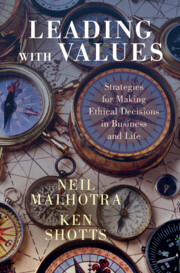Book contents
- Leading With Values
- Leading With Values
- Copyright page
- Dedication
- Contents
- Figures and Tables
- Acknowledgments
- 1 Core Values
- 2 Follow Your Gut?
- 3 Self-Deception and Rationalization
- 4 The Power of the Situation
- 5 Shareholders, Stakeholders, and Societal Institutions
- 6 Weighing Consequences
- 7 Perspective-Taking
- 8 Being Fair
- 9 What Are Your Core Values?
- Notes
- Index
8 - Being Fair
Published online by Cambridge University Press: 27 January 2022
- Leading With Values
- Leading With Values
- Copyright page
- Dedication
- Contents
- Figures and Tables
- Acknowledgments
- 1 Core Values
- 2 Follow Your Gut?
- 3 Self-Deception and Rationalization
- 4 The Power of the Situation
- 5 Shareholders, Stakeholders, and Societal Institutions
- 6 Weighing Consequences
- 7 Perspective-Taking
- 8 Being Fair
- 9 What Are Your Core Values?
- Notes
- Index
Summary
People often demand that leaders be “fair.” But what exactly does fairness mean? What Person A perceives as fair often strikes Person B as unfair, particularly if Person A is the “winner” and Person B is the “loser” in a situation. One of the biggest challenges that leaders face in organizations is the clarion call of “But that’s not fair!” In this chapter, we will delve into the concept of fairness, motivated by philosophical theories of justice.
- Type
- Chapter
- Information
- Leading With ValuesStrategies for Making Ethical Decisions in Business and Life, pp. 126 - 139Publisher: Cambridge University PressPrint publication year: 2022

